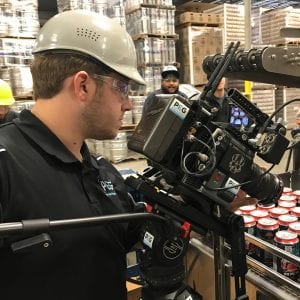RED Scarlet-W First Impressions

A couple months ago, we took delivery of an item we’ve been waiting on for quite a while here at PEG, our first RED camera. We’ve been wanting a RED for some time now, for the obvious reasons of “RAW is better” and “RED cameras set the pace of what is considered good in the industry,” as well as more real-world reasons of “LOG workflows are kind of a massive pain.”
For the last 3-5 years we’ve relied on Sony cinema cams as our day-to-day workhorses, starting with an FS700, then adding a FS7 when Sony pushed that, and finally adding an additional FS7 for multi-camera shoots mid-2016. We’ve had great results, and even after working with REDs and getting our hands on a few ARRI rigs, I’d still argue that the FS7 is the best run-and-gun cinema cam on the market, short of the rare AMIRA rigs you see running around. But they’re not perfect.
RAW is basically impossible, so you have to rely on using S-LOG 3 for acquisition that really lets you use the full capability of the sensor, which if you’ve ever exposed with it in-camera, is not the easiest process. On top of that the convenience of having a camera body with everything built right in has the trade-off of the overall body length being too long to use on practically any unmodified gimbal, plus the lens mounts don’t swap so you’re left adapting Sony’s rarely used lens mount and adding lens supports (Bigger, longer, heavier….). Over several years those annoyances start to add up, and coupled with the image quality difference, we decided to look towards RED as our next camera purchase.
After taking it out for our first big shoot with it recently, in Denver, here are our top pros and cons of our new RED Scarlet-W 5k camera, with everything being relative to our 3+ years of experience with Sony’s cinema line. Pros: - This thing is a transformer As mentioned, the FS7s we’re coming from (And especially the old FS700s) have the problem of not really being built up or down. Their bodies are long, and that’s just how it is. The beauty of the RED modular system is that it can be built very small for gimbal or specialty usage, or built up quite a bit larger for handheld and studio operations.
In the field on our last shoot at a brewery, we had a variety of scenarios, and the RED’s ability to transform mid-shoot was vital to capturing a huge variety of footage all in one day with a relatively small shoot. - Graded from the start It may not sound like a big deal from an outside perspective, but the ability to check exposure easily in-camera is a massive upgrade from Sony’s S-LOG workflow. Especially in certain edge-case scenarios with the FS7s, you literally need to switch modes just to check exposure using a LUT, set your exposure with a “normal” pre-graded image, and switch back to 4k mode, where you monitor your shot in an ungraded S-LOG view. That’s a huge pain, and it costs valuable time on-set.
With the RED, you’ve got the ability to set your exposure ALWAYS using a pre-graded, “REDcolor” image. Pair that with the fact that you can white balance it in the field (Again, I’m looking at your Sony) and the flexibility of the REDCODE workflow in post, and the RED easily pulls ahead of the pack. Cons - No internal NDs Coming from a world where ND filters are built right into the camera, the RED is quite the headache when the situation calls for a filter. On many cine cams, including our Sonys, if you need to get neutral density into the shot it’s as easy as a quick switch on the side of a camera.
But as previously mentioned, RED wants everything modular. Which is great, except when you really just want to flip that switch on the camera to get the shot, and instead have to rely on a matte box or screw on filters to get ND into the mix. Given how fast most of our shoots move, it’s just a pain, honestly, but given RED’s approach to filters it seems it-is-what-it-is. - Batteries. This thing eats batteries. No, seriously.
We use Anton Bauer batteries on pretty much everything at PEG, and with our old FS7 models when we first started using them they all ran with ATOMOS Shoguns or Blades on them for ProRes capture and easy monitoring. With that build-up we got only a few hours of life out of them. Mid-2016 we added Sony’s ProRes modules to the backs of the cams (Which made them even longer, sigh….) which allowed us to drop off the ATOMOS gear on many shoots. This brought our battery life to sometimes as long as 2-3 hours, which was a lifesaver on run-and-gun setups. On our last shoot with the RED, on Anton Bauer Dionic-HCs, we would be lucky to get an hour out of the RED, even with no external components. Matter of fact, they discharged the batteries so fast when we pulled the bricks they were noticeably hot to the touch and required a cool-down period to get to a rechargeable state.
Needless to say, for future shoots we’re going to have to double our normal battery supply on-set or really invest into specialty batteries like Anton Bauer cinema series. All in all, the positives far outweighed the negatives, and as we continue to get even more experienced using our new RED, we can’t wait to see how many more things we’ll learn and how many incredible shoots we’ll be able to take it on.




